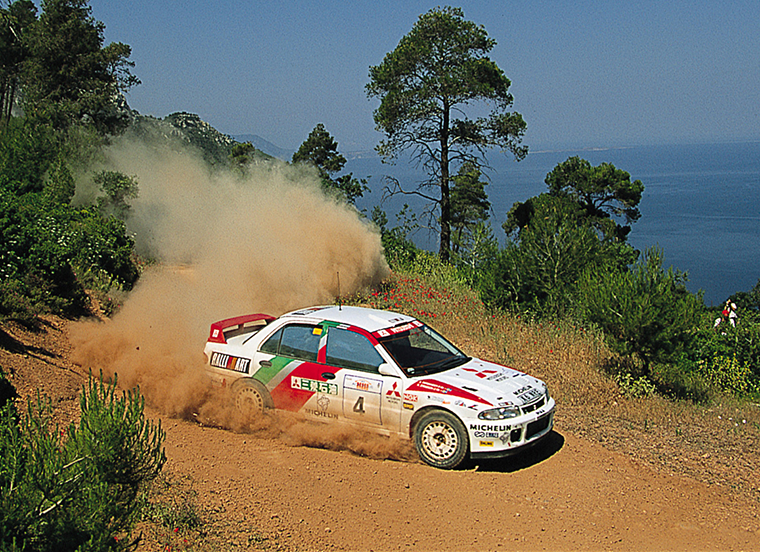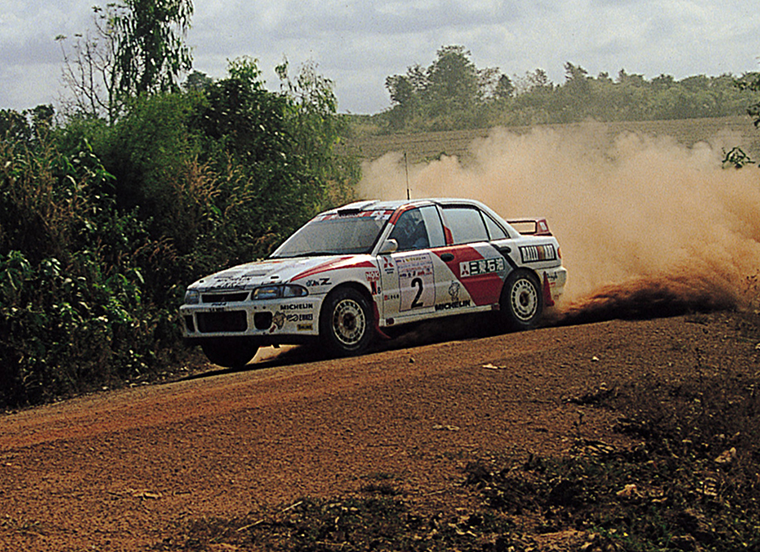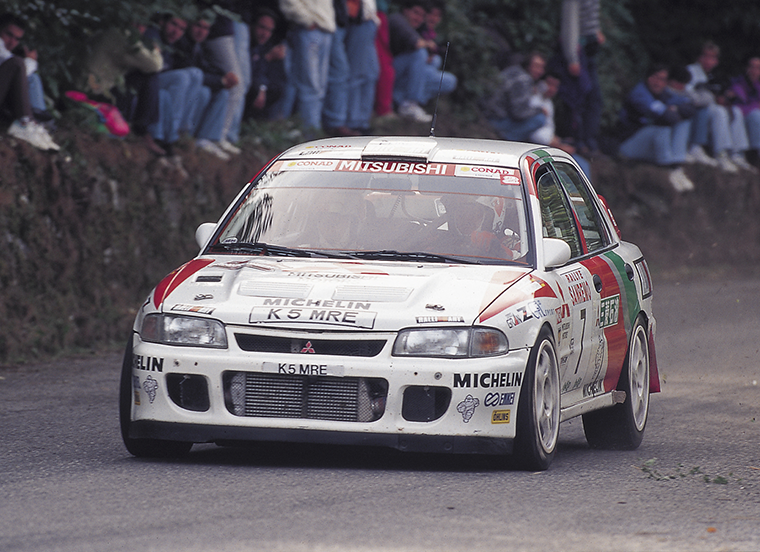WRC 1994
1994 World Rally Championship
The MITSUBISHI MOTORS team, which had finished the previous year's season in an upswing, entered the 1994 season of the World Rally Championship (WRC) with an unchanged lineup of drivers. At the opening Monte Carlo Rally, the team continued to field the Group A LANCER EVOLUTION. Armin Schwarz achieved nine fastest times while Kenneth Eriksson scored two fastest times. Although the final results were seventh for Schwarz and fifth for Eriksson, this rally brought a satisfying feeling of achievement.
| Rd. | name | Country |
|---|---|---|
| 1 | Monte Carlo Rally | Europe, France, Africa and Monaco |
| 2 | Rallye de Portugal | Portugal |
| 3 | Safari Rally | Kenya |
| 4 | Tour de Corse | France |
| 5 | Acropolis Rally | Greece |
| 6 | Rally Argentina | Argentina |
| 7 | Rally New Zealand | New Zealand |
| 8 | 1000 Lakes Rally | Finland |
| 9 | Rallye Sanremo | Italy |
| 10 | RAC Rally | United Kingdom |
 The MITSUBISHI MOTORS works team operated by RALLIART Europe did not enter the third round, the Safari Rally, but Kenjiro Shinozuka, an appointed driver who has been involved in both vehicle and team management in Japan since 1990, did participate. He overcame a gearbox issue to finish second, the highest result for a Japanese driver competing in the Safari Rally at the time.
The MITSUBISHI MOTORS works team operated by RALLIART Europe did not enter the third round, the Safari Rally, but Kenjiro Shinozuka, an appointed driver who has been involved in both vehicle and team management in Japan since 1990, did participate. He overcame a gearbox issue to finish second, the highest result for a Japanese driver competing in the Safari Rally at the time.At the next Acropolis Rally in Greece, the MITSUBISHI MOTORS team switched to a car based on the LANCER EVOLUTION II. The LANCER EVOLUTION II was launched in January 1994 and more than the minimum production volume required for homologation in Group A/N, which was 2,500 standard production units. Even though he was hit by a series of issues with transmission parts, Schwarz carried on tenaciously to finish second. Together with Eriksson, who was forced into retirement, they achieved fastest times in nine out of 33 special stages (SS), demonstrating their abilities.

 The MITSUBISHI MOTORS works team's next race was the opening round of the Asia-Pacific Rally Championship (APRC). Subaru had started participating in the APRC from the previous year. Given the importance of the Asian market, MITSUBISHI MOTORS couldn't stay on the sidelines. They sent out a Group A LANCER EVOLUTION from Great Britain in order for Eriksson to take part in the entire series. In the first APRC round, the Indonesia Rally, Eriksson won, beating Subaru's Possum Bourne (New Zealand) and Richard Burns (Great Britain), who later on joined theMITSUBISHI MOTORS Team.
The MITSUBISHI MOTORS works team's next race was the opening round of the Asia-Pacific Rally Championship (APRC). Subaru had started participating in the APRC from the previous year. Given the importance of the Asian market, MITSUBISHI MOTORS couldn't stay on the sidelines. They sent out a Group A LANCER EVOLUTION from Great Britain in order for Eriksson to take part in the entire series. In the first APRC round, the Indonesia Rally, Eriksson won, beating Subaru's Possum Bourne (New Zealand) and Richard Burns (Great Britain), who later on joined theMITSUBISHI MOTORS Team.At the APRC’s last round, the Thailand Rally, the MITSUBISHI MOTORS team finally put into use their electronically-controlled active differential system, for which had carried out research and development work for many years. The handling characteristics of the LANCER EVOLUTION II equipped with this newly developed active differential system were better than ever before. At the wheel of that car, Eriksson won the rally. Unfortunately, he did not win the APRC series title, but he was able to achieve excellent results, which were reflected in both the classification and his driving abilities. Meanwhile, Schwarz and Ericsson finished third and fourth in the Rally New Zealand, which counted towards both APRC and WRC. At the Rally Sanremo (Italy), Tommi Mäkinen, who was promised he would be given a chance the year before, was appointed to the works team for the first time.

Result
| Rd. | 1 | 2 | 3 | 4 | 5 | 6 | 7 | 8 | 9 | 10 |
|---|---|---|---|---|---|---|---|---|---|---|
| Armin Schwarz | 7th | 2nd | 3rd | R | ||||||
| Klaus Wicha | ||||||||||
| K. Eriksson | 5th | R | 4th | |||||||
| S. Parmander | ||||||||||
| K. Shinozuka | 2nd | |||||||||
| P. Kuukkala |
| Driver | Co-driver | R - Retired | D - Disqualified |
| Rd. | 1 | 2 | 3 | 4 |
|---|---|---|---|---|
| Armin Schwarz | 7th | |||
| Klaus Wicha | ||||
| K. Eriksson | 5th | |||
| S. Parmander | ||||
| S. Parmander | 2nd | |||
| P. Kuukkala |
| 5 | 6 | 7 | 8 | 9 | 10 |
|---|---|---|---|---|---|
| 2nd | 3rd | R | |||
| R | 4th | ||||
Driver
Co-driver
R - Retired
D - Disqualified
Spec
LANCER Evolution Ⅱ
| Overall length | 4,310 mm |
|---|---|
| Overall width | 1,695 mm |
| Engine model | 4G63 4-cylinder DOHC turbo |
| Displacement | 1,997 cc |
| Maximum output | 295 ps |
| Maximum torque | 45.9 kg-m |
